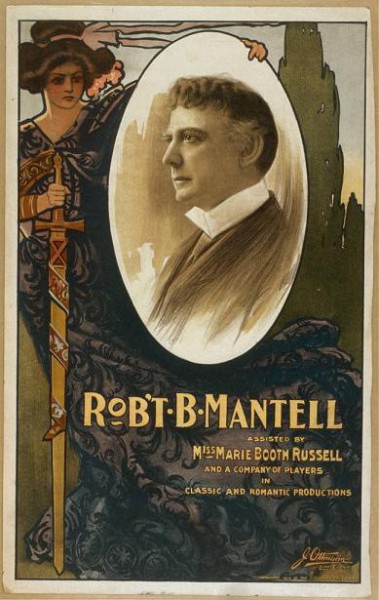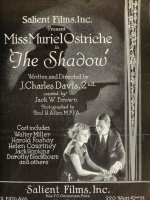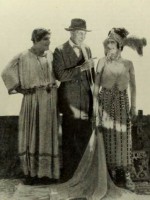Robert B. Mantell est un Acteur Britannique né le 7 février 1854 à Irvine (Royaume-uni)

Robert Bruce Mantell (February 7, 1854 – June 27, 1928) was a heralded Shakespearean stage actor who made several silent films. His mother was Elizabeth Bruce Mantell who objected to her son becoming an actor so he used the name 'Robert Hudson' early in his career. Mantell first came to the United States in 1874 and stayed two weeks with no theatrical success. He returned in 1878 in support of Helena Modjeska but didn't stay. In 1883 he found success on Broadway supporting Fanny Davenport as her leading man in Fedora. For the remainder of his theatrical career he played Shakespeare and high class drama. Mantell was also famous for having had many marriages and he often performed with his wives in Shakespearean productions. His last wife, Genevieve Hamper (1888–1971), was 35 years his junior, and bore him a son Bruce Mantell Jr. (1912–1933).
Mantell began in films at 61 in 1915 working at Fox Studios with J. Gordon Edwards, who directed all of his films except the last. Under the Red Robe (1923) was directed by Alan Crosland and distributed through Goldwyn Pictures. As with most early Fox films, all of Mantell's films from that studio are lost. Elements of Under the Red Robe are held at George Eastman House in Rochester, New York.
Actor Robert Bruce Mantell was the third child of James and Elizabeth Mantell.(Bulliet p. 21)Note: Robert was actually the seventh child in the family (twins count as two)...Bulliet had several inconsistencies in his book. My mother, RBM's granddaughter, said the family had a laugh over several, but it is a fun read and captures the family stories. Laurie H. Sisson (USA) added 2014 after a discussion with Nancy in Scotland from the Mantell branch of the family.
He was born February 7, 1854, in Irvine, Scotland, at the Wheatsheaf Inn—which his mother and father owned and operated. (Bulliet, pp. 20, 21) Mantell’s mother, born Elizabeth Bruce, could trace her lineage to ancient Scotland’s famous Robert The Bruce. (Bulliet, p. 12)
When “Bobbie,” as he was known, was 5 years old his parents sold the Wheatsheaf Inn and moved to Dublin to take over management of a larger public house, which they christened the Eglington-Winton. (Bulliet, p. 23)
Robert Mantell attended Model School, then Gribben’s Penny School, then Miss Smith’s school for Boys and Girls, then Dr. Rennie’s school for boys, then William Campbell’s school. He was dismissed from each for disciplinary problems. It wasn’t until he was enrolled at McClinton’s Seminary that he finally obtained something of a formal education. (Bulliet, pp. 27–30)
In the book, “Robert Mantell’s Romance,” Clarence J. Bulliet writes that in Dublin “there was a dramatic club, which young Bob Mantell, semi-clandestinely, because of parental objections, was one of the burning tapers”. (Bulliet, p. 13)
Mantell may have first been drawn to the entertainment industry by P. T. Barnum whom Robert remembered staying at the Wheatsheaf Inn when young Robert was only 3. (Bulliet, p. 22) Mantell may have caught the acting bug from amateur theatricals—such as “Alonzo The Brave “ and “The Fair Imogene”—which the family put on at their public house during the Christmas season when guests were few. (Bulliet, p. 25)
While his mother approved of such amateur stage productions, she had “a horror of the professional stage”. (Bulliet, p. 14)
When Robert resolved to pursue a career on the stage, his mother refused to assist him – refused, that is, until he swore to change his name to Robert Hudson and to go to America to ply his craft. With this, Robert’s mother presented Robert with “the same little sum of money she had given his older brothers when they started out into the world” (Bulliet, p. 57) and off he went.
After a mere 10 days in Boston, with no job and no prospects, Robert was down to exactly enough money to purchase a return ticket. Another day in Boston and he’d have been stuck in America. So he bought a ticket on the Hecla and returned home to Ireland. (Bulliet, p. 58)
His first theatrical job (still using the name Robert Hudson) was with a stock company at the Theatre Royal, in Rochdale, Lancashire where, on Oct. 21, 1876, he made his stage debut in Dion Boucicault’s “Arrah-Na-Pogue”. (Bulliet, p. 60)
The company disbanded after one year, (Bulliet, p. 63) and Mantell joined the Heffernan company, performing abbreviated versions of MacBeth, Othello, Richard III and Hamlet that were “so hydraulically condensed that he could give ten or a dozen performances a day”. (Bulliet, p. 64)
Then Mantell joined the company of Alice Marriott (Bulliet, p. 66) during which time he was frequently in the company and society of no less than Sir Francis Drake and Francis Lord Bacon. (Bulliet, p. 67).
He remained in the employ of the Marriott company until 1878 when he set sail once again for America. Using his real name for the first time, Mantell got the role of Tibalt in the Leyland Opera House’s production of Shakespeare’s “Romeo and Juliet.” Mantell kept a diary of his American tour:
> Mar. 3 – Terre Haute, Indiana – Small place
> Mar. 4 – Lafayette, Indiana – Small place
> Mar. 6 – Springfield, Ohio – Small place
(Bulliet, pp. 77, 78)
Mantell’s first American tour also took him to Baltimore (“Great place for oysters”) and New Orleans (“Wouldn’t live in it for anything.”). It took him to Indianapolis, Indiana (“Something like Belfast”) and to Louisville, Kentucky (“A very nice city”) in addition to New York (which he liked) and Washington, DC, (which he did not). On May 17, 1878, Mantel sailed home for England, unaware that his first tour of America would not be his last. (Bulliet, pp. 80–82)
In England, Mantell joined the company of the esteemed actor-manager George S. Knight portraying Iago in Shakespeare’s “Othello” opposite Frank Clement who played the Moor. (Bulliet, p. 84) And while in Knight’s company he played several roles in Shakespeare’s “Romeo and Juliet,” “Hamlet,” and “MacBeth.”
In 1883 he was once again headed to America. Mantell’s first leading role in America was as Sir Clement Huntingford in “The World.” (Bulliet, p. 98) He attained critical and popular acclaim in the role of Loris Ipanoff in Fanny Davenport’s 1883–1884 production of “Fedora.” After that, leading roles came quickly and steadily. (Bulliet, pp. 101–105)
He starred in John Keller's “Tangled Lives” in 1886, starred in “The Marble Heart” in 1887, and in “Monbars” in 1887–88. By 1890, “Mantell believed himself strong enough to venture on a tour on his own account, after the fashion of the English actor-managers and pocket all the profits.” (Bulliet, p. 133)
Mantell married Marie Sheldon, who bore him two sons, Robert and Jack, but fame and traveling are hard on a marriage and Marie soon sued Robert for divorce. Alimony demands and arrest warrants for nonsupport kept Mantell out of New York for years. (Bulliet, p. 140)
Mantell subsequently married Charlotte Behrens who bore him a daughter, Ethel Mantell, in 1895. (Bulliet, p. 141)
In the late summer of 1892 Mantell opened at New York’s Proctors Theatre in Charles Osborne’s The Face in the Moonlight with Caroline Miskel-Hoyt, a young actress who was just at the beginning of her brief career on Broadway.
In the last 5 years of the 19th century he toured extensively, putting on performances of “Monbars,” “Othello,” “Hamlet,” and “The Corsican Brothers” in town after town, state after state—everywhere but New York. (Bulliet, pp. 167–169)
When the lawyers finally resolved his alimony difficulties, Mantell—now significantly older—returned to New York, but not as a romantic lead, as he had been known for so many years, but as a classic tragedian. One of his first leading roles after his return to New York was as Richard III, where he demonstrated that “the line of great tragedians on the American stage had not ended with Edwin Booth”. (Bulliet, p. 169)
Work came easily for Mantell after that. At one point Mantell was starring in “Richard III” one week, “Richelieu” the second week, “Othello” the third week, and “Hamlet” the fourth week in rotation. (Bulliet p. 188)
Mantell played Caudor in “MacBeth” may times over. His biographer, Clarence Bulliet, said none ever played the role better. Bulliet also said that Mantell’s portrayal of “King John”—in a version of Shakespeare’s chronicle edited by Mantell himself—was so intense (especially the death scene where great drops of Vaseline melted and dripped from his stringy red beard under the hot stage lights) that few who saw Mantell play the ill-fated king were ever able to forget it. (Bulliet, p. 222)
But “King Lear" was by far his “masterwork”. (Bulliet, p. 191) He played the role over and over, refining and perfecting it from the 1910s almost until his death in 1928.
In 1913 Mantell got a press agent/business agent, Clarence J. Bulliet (ne Clarence J. Bulleit, of Corydon, Indiana) who later became Art Critic for the Chicago Evening Post (1924–1932) and the Chicago Daily News (1932–1952). It was Bulliet who, in 1918, wrote the definitive biography on Robert Bruce Mantell called “Robert Mantell’s Romance,” published by John Luce & Company, 1918.
Source : Wikidata
Robert B. Mantell

- Infos
- Photos
- Meilleurs films
- Famille
- Personnages
- Récompenses
Nom de naissance Robert Bruce Mantell
Nationalité Royaume-uni
Naissance 7 février 1854 à Irvine (Royaume-uni)
Mort 27 juin 1928 (à 74 ans) à Atlantic Highlands (Etats-Unis)
Nationalité Royaume-uni
Naissance 7 février 1854 à Irvine (Royaume-uni)
Mort 27 juin 1928 (à 74 ans) à Atlantic Highlands (Etats-Unis)
Mantell began in films at 61 in 1915 working at Fox Studios with J. Gordon Edwards, who directed all of his films except the last. Under the Red Robe (1923) was directed by Alan Crosland and distributed through Goldwyn Pictures. As with most early Fox films, all of Mantell's films from that studio are lost. Elements of Under the Red Robe are held at George Eastman House in Rochester, New York.
Biographie
(From here on, the text while informative, seems to be lifted verbatim from an outside source despite some attempt at references. A rewrite in an editor's own hand would be helpful)Actor Robert Bruce Mantell was the third child of James and Elizabeth Mantell.(Bulliet p. 21)Note: Robert was actually the seventh child in the family (twins count as two)...Bulliet had several inconsistencies in his book. My mother, RBM's granddaughter, said the family had a laugh over several, but it is a fun read and captures the family stories. Laurie H. Sisson (USA) added 2014 after a discussion with Nancy in Scotland from the Mantell branch of the family.
He was born February 7, 1854, in Irvine, Scotland, at the Wheatsheaf Inn—which his mother and father owned and operated. (Bulliet, pp. 20, 21) Mantell’s mother, born Elizabeth Bruce, could trace her lineage to ancient Scotland’s famous Robert The Bruce. (Bulliet, p. 12)
When “Bobbie,” as he was known, was 5 years old his parents sold the Wheatsheaf Inn and moved to Dublin to take over management of a larger public house, which they christened the Eglington-Winton. (Bulliet, p. 23)
Robert Mantell attended Model School, then Gribben’s Penny School, then Miss Smith’s school for Boys and Girls, then Dr. Rennie’s school for boys, then William Campbell’s school. He was dismissed from each for disciplinary problems. It wasn’t until he was enrolled at McClinton’s Seminary that he finally obtained something of a formal education. (Bulliet, pp. 27–30)
In the book, “Robert Mantell’s Romance,” Clarence J. Bulliet writes that in Dublin “there was a dramatic club, which young Bob Mantell, semi-clandestinely, because of parental objections, was one of the burning tapers”. (Bulliet, p. 13)
Mantell may have first been drawn to the entertainment industry by P. T. Barnum whom Robert remembered staying at the Wheatsheaf Inn when young Robert was only 3. (Bulliet, p. 22) Mantell may have caught the acting bug from amateur theatricals—such as “Alonzo The Brave “ and “The Fair Imogene”—which the family put on at their public house during the Christmas season when guests were few. (Bulliet, p. 25)
While his mother approved of such amateur stage productions, she had “a horror of the professional stage”. (Bulliet, p. 14)
When Robert resolved to pursue a career on the stage, his mother refused to assist him – refused, that is, until he swore to change his name to Robert Hudson and to go to America to ply his craft. With this, Robert’s mother presented Robert with “the same little sum of money she had given his older brothers when they started out into the world” (Bulliet, p. 57) and off he went.
After a mere 10 days in Boston, with no job and no prospects, Robert was down to exactly enough money to purchase a return ticket. Another day in Boston and he’d have been stuck in America. So he bought a ticket on the Hecla and returned home to Ireland. (Bulliet, p. 58)
His first theatrical job (still using the name Robert Hudson) was with a stock company at the Theatre Royal, in Rochdale, Lancashire where, on Oct. 21, 1876, he made his stage debut in Dion Boucicault’s “Arrah-Na-Pogue”. (Bulliet, p. 60)
The company disbanded after one year, (Bulliet, p. 63) and Mantell joined the Heffernan company, performing abbreviated versions of MacBeth, Othello, Richard III and Hamlet that were “so hydraulically condensed that he could give ten or a dozen performances a day”. (Bulliet, p. 64)
Then Mantell joined the company of Alice Marriott (Bulliet, p. 66) during which time he was frequently in the company and society of no less than Sir Francis Drake and Francis Lord Bacon. (Bulliet, p. 67).
He remained in the employ of the Marriott company until 1878 when he set sail once again for America. Using his real name for the first time, Mantell got the role of Tibalt in the Leyland Opera House’s production of Shakespeare’s “Romeo and Juliet.” Mantell kept a diary of his American tour:
> Mar. 3 – Terre Haute, Indiana – Small place
> Mar. 4 – Lafayette, Indiana – Small place
> Mar. 6 – Springfield, Ohio – Small place
(Bulliet, pp. 77, 78)
Mantell’s first American tour also took him to Baltimore (“Great place for oysters”) and New Orleans (“Wouldn’t live in it for anything.”). It took him to Indianapolis, Indiana (“Something like Belfast”) and to Louisville, Kentucky (“A very nice city”) in addition to New York (which he liked) and Washington, DC, (which he did not). On May 17, 1878, Mantel sailed home for England, unaware that his first tour of America would not be his last. (Bulliet, pp. 80–82)
In England, Mantell joined the company of the esteemed actor-manager George S. Knight portraying Iago in Shakespeare’s “Othello” opposite Frank Clement who played the Moor. (Bulliet, p. 84) And while in Knight’s company he played several roles in Shakespeare’s “Romeo and Juliet,” “Hamlet,” and “MacBeth.”
In 1883 he was once again headed to America. Mantell’s first leading role in America was as Sir Clement Huntingford in “The World.” (Bulliet, p. 98) He attained critical and popular acclaim in the role of Loris Ipanoff in Fanny Davenport’s 1883–1884 production of “Fedora.” After that, leading roles came quickly and steadily. (Bulliet, pp. 101–105)
He starred in John Keller's “Tangled Lives” in 1886, starred in “The Marble Heart” in 1887, and in “Monbars” in 1887–88. By 1890, “Mantell believed himself strong enough to venture on a tour on his own account, after the fashion of the English actor-managers and pocket all the profits.” (Bulliet, p. 133)
Mantell married Marie Sheldon, who bore him two sons, Robert and Jack, but fame and traveling are hard on a marriage and Marie soon sued Robert for divorce. Alimony demands and arrest warrants for nonsupport kept Mantell out of New York for years. (Bulliet, p. 140)
Mantell subsequently married Charlotte Behrens who bore him a daughter, Ethel Mantell, in 1895. (Bulliet, p. 141)
In the late summer of 1892 Mantell opened at New York’s Proctors Theatre in Charles Osborne’s The Face in the Moonlight with Caroline Miskel-Hoyt, a young actress who was just at the beginning of her brief career on Broadway.
In the last 5 years of the 19th century he toured extensively, putting on performances of “Monbars,” “Othello,” “Hamlet,” and “The Corsican Brothers” in town after town, state after state—everywhere but New York. (Bulliet, pp. 167–169)
When the lawyers finally resolved his alimony difficulties, Mantell—now significantly older—returned to New York, but not as a romantic lead, as he had been known for so many years, but as a classic tragedian. One of his first leading roles after his return to New York was as Richard III, where he demonstrated that “the line of great tragedians on the American stage had not ended with Edwin Booth”. (Bulliet, p. 169)
Work came easily for Mantell after that. At one point Mantell was starring in “Richard III” one week, “Richelieu” the second week, “Othello” the third week, and “Hamlet” the fourth week in rotation. (Bulliet p. 188)
Mantell played Caudor in “MacBeth” may times over. His biographer, Clarence Bulliet, said none ever played the role better. Bulliet also said that Mantell’s portrayal of “King John”—in a version of Shakespeare’s chronicle edited by Mantell himself—was so intense (especially the death scene where great drops of Vaseline melted and dripped from his stringy red beard under the hot stage lights) that few who saw Mantell play the ill-fated king were ever able to forget it. (Bulliet, p. 222)
But “King Lear" was by far his “masterwork”. (Bulliet, p. 191) He played the role over and over, refining and perfecting it from the 1910s almost until his death in 1928.
In 1913 Mantell got a press agent/business agent, Clarence J. Bulliet (ne Clarence J. Bulleit, of Corydon, Indiana) who later became Art Critic for the Chicago Evening Post (1924–1932) and the Chicago Daily News (1932–1952). It was Bulliet who, in 1918, wrote the definitive biography on Robert Bruce Mantell called “Robert Mantell’s Romance,” published by John Luce & Company, 1918.
Le plus souvent avec
Filmographie de Robert B. Mantell (3 films)
Acteur

Under the Red Robe (1923)
Réalisé par Alan Crosland
Origine Etats-Unis
Genres Drame, Historique
Acteurs Robert B. Mantell, Alma Rubens, Otto Kruger, William Powell, Mary MacLaren, Gustav von Seyffertitz
Rôle Cardinal Richelieu

Tangled Lives (1917)
Réalisé par J. Gordon Edwards
Origine Etats-Unis
Acteurs Robert B. Mantell, Stuart Holmes, Walter Miller, Claire Whitney, Jane Lee
Rôle Dassori

A Wife's Sacrifice (1916)
Réalisé par J. Gordon Edwards
Origine Etats-Unis
Acteurs Robert B. Mantell, Claire Whitney, Stuart Holmes, Walter Miller, Jane Lee
Rôle Count de Moray
 Connexion
Connexion




